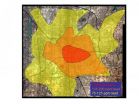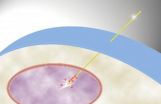(Press-News.org) INDIANAPOLIS – Not since victory gardens helped World War II era Americans on the home front survive food shortages have urban gardens been as necessary and popular as they are today. With more food production in cities, the safety of the produce grown there becomes increasingly important.
As city dwellers across the country are harvesting fruits and vegetables for family consumption and planning ahead for the next planting season, geochemist Gabriel Filippelli, Ph.D., professor of earth sciences at the School of Science at Indiana University-Purdue University Indianapolis, warns that urban soil may be contaminated with lead. He advises investigating the legacy of contamination in soil before planting and eating.
"Most surface contamination in urban settings like Baltimore, Brooklyn, Detroit or Indianapolis is from harmful metals, especially lead, and tends to be found near roadways, older homes or lead smelters. Sources of contamination can be automobile exhaust, degraded paint, tire and vehicle debris, industrial emissions or other products of human technology," said Filippelli, who is an international leader in the emerging field of medical geology.
He encourages urban gardeners to study a map of their metropolitan area and determine potential soil contamination risk by proximity to busy streets, major roadways, freeways, dilapidated painted structures or older industrial facilities.
Gardens with no or low levels of lead contamination as determined by location or with test results of less than 200 parts per million (ppm) can be abundantly planted, but may benefit from high phosphate fertilizer which immobilizes metals like lead.
For gardens at medium risk based on location or soil tested at 200-500 ppm, he recommends covering the soil, planting in raised bed settings, and mulching between beds to reduce the risks of tracking lead-rich soil onto the plots or into the home.
For gardens at high lead risk or found to have lead levels of over 500 ppm, he counsels proceeding with caution as contamination could be coming from the soil below and the air above. While taller fruit plants are probably safe to consume, root vegetables and leafy greens like lettuce and kale are not, mainly because of the difficulties of cleaning this produce thoroughly before consumption. In this setting, raised-bed planting is critical, as is ensuring mulch or ground cover between beds and extending for 10 feet around the perimeter of the garden.
The produce of all urban gardens, even those at low risk of contamination, should be washed carefully.
"Urban gardens are powerful tools for personal health and for neighborhood revitalization. These plots should be encouraged but need to be tended with special care to ensure that lead does not adhere to the food children and adults are consuming," said Filippelli.
This season, Filippelli and School of Science students are analyzing lead levels in multiple soil samples from an initial 25 urban gardens. They hope to acquire funding to test many more urban plots beginning this autumn to inform urban dwellers, policy makers and researchers.
"Environmental awareness can ensure that a garden is a healthy place to work and that food is safe to eat and share," said Filippelli who has studied lead contamination in urban soil for almost a decade.
INFORMATION:
The School of Science at IUPUI is committed to excellence in teaching, research, and service in the biological, physical, behavioral and mathematical sciences. The School is dedicated to being a leading resource for interdisciplinary research and science education in support of Indiana's effort to expand and diversify its economy. For more information visit www.science.iupui.edu.
Urban gardeners beware: There may be lead in your soil and food
2010-09-28
ELSE PRESS RELEASES FROM THIS DATE:
A shot to the heart: Nanoneedle delivers quantum dots to cell nucleus
2010-09-28
CHAMPAIGN, Ill. — Getting an inside look at the center of a cell can be as easy as a needle prick, thanks to University of Illinois researchers who have developed a tiny needle to deliver a shot right to a cell's nucleus.
Understanding the processes inside the nucleus of a cell, which houses DNA and is the site for transcribing genes, could lead to greater comprehension of genetics and the factors that regulate expression. Scientists have used proteins or dyes to track activity in the nucleus, but those can be large and tend to be sensitive to light, making them hard ...
Study: Electric cars hold greater promise for reducing emissions and lowering US oil imports
2010-09-28
Electric cars hold greater promise for reducing emissions and lowering U.S. oil imports than a national renewable portfolio standard, according to research conducted by Rice University's Baker Institute for Public Policy.
This assessment is among several contained in a new major policy study the Baker Institute Energy Forum will release at a Sept. 27-28 conference titled "Energy Market Consequences of an Emerging U.S. Carbon Management Policy." The study comprises several academic working papers on a variety of topics, such as carbon pricing, the wind industry, global ...
How injured nerves grow themselves back
2010-09-28
Unlike nerves of the spinal cord, the peripheral nerves that connect our limbs and organs to the central nervous system have an astonishing ability to regenerate themselves after injury. Now, a new report in the October 1st issue of Cell, a Cell Press publication, offers new insight into how that healing process works.
"We know a lot about how various cell types differentiate during development, but after a serious injury like an amputation, nerves must re-grow," said Allison Lloyd of University College London. "They need a new mechanism to do that because the developmental ...
Rain or shine, Sandia researchers find new ways to forecast large photovoltaic power plant output
2010-09-28
ALBUQUERQUE, N.M. – Sandia National Laboratories researchers have developed a new system to monitor how clouds affect large-scale solar photovoltaic (PV) power plants. By observing cloud shape, size and movement, the system provides a way for utility companies to predict and prepare for fluctuations in power output due to changes in weather. The resulting models will provide utility companies with valuable data to assess potential power plant locations, ramp rates and power output.
Sandia researchers' work is currently focused at the 1.2-megawatt La Ola Solar Farm on ...
New guideline finds no evidence for a popular back procedure
2010-09-28
Rosemont, Ill. – As a patient safety best practice and endorsement of evidence-based medicine, the American Academy of Orthopaedic Surgeons (AAOS) Board of Directors approved and released a clinical practice guideline, which found a strong recommendation against a popular procedure called vertebroplasty as a way to treat fractures in the spine. Clinical practice guidelines are one avenue the Academy uses to ensure that patients receive high quality care.
Vertebroplasty is a surgical procedure developed to reduce or eliminate the pain associated with compression fractures ...
Sugary sports drinks mistakenly associated with being healthy, say UTHealth researchers
2010-09-28
HOUSTON (Sept. 27, 2010) – Children who practice healthy lifestyle habits such as eating fruits and vegetables and engaging in physical activity may be negatively impacting their health because they tend to consume large amounts of flavored and sports beverages containing sugar, according to research at The Michael & Susan Dell Center for Healthy Living at The University of Texas Health Science Center at Houston (UTHealth).
"Children and parents associate these drinks with a healthy lifestyle despite their increased amount of sugar and lack of nutritional value," said ...
Onconova Therapeutics presents new data demonstrating radioprotection by Ex-RAD at RRS annual meeting
2010-09-28
Newtown, PA, September 27, 2010 – Onconova Therapeutics, Inc. is presenting new data in five posters and an oral presentation this week summarizing several studies with the company's radioprotectant Ex-RAD® at the 56th Annual Meeting of the Radiation Research Society (RRS), September 25-29 in Maui, Hawaii. In vivo studies show that Ex-RAD®, upon oral administration, produced a significant increase in survival versus placebo-treated groups in mice exposed to lethal whole body irradiation (WBI), for both prophylactic pre-treatment and mitigation post-treatment. ...
'Gold' fish thrive, cancers die
2010-09-28
Rice University physicist Dmitri Lapotko has demonstrated that plasmonic nanobubbles, generated around gold nanoparticles with a laser pulse, can detect and destroy cancer cells in vivo by creating tiny, shiny vapor bubbles that reveal the cells and selectively explode them.
A paper in the October print edition of the journal Biomaterials details the effect of plasmonic nanobubble theranostics on zebra fish implanted with live human prostate cancer cells, demonstrating the guided ablation of cancer cells in a living organism without damaging the host.
Lapotko and his ...
Family, culture affect whether intelligence leads to education
2010-09-28
Intelligence isn't the only thing that predicts how much education people get; family, culture, and other factors are important, too. A new study published in Psychological Science, a journal of the Association for Psychological Science, compares identical and fraternal twins in Minnesota and Sweden to explore how genetic and environmental factors involved in educational differ in countries with different educational systems. Family background can get an education even for people of low intelligence, the authors conclude—but helps much more in Minnesota, than in Sweden.
The ...
Right or left? Brain stimulation can change which hand you favor
2010-09-28
BERKELEY — Each time we perform a simple task, like pushing an elevator button or reaching for a cup of coffee, the brain races to decide whether the left or right hand will do the job. But the left hand is more likely to win if a certain region of the brain receives magnetic stimulation, according to new research from the University of California, Berkeley.
UC Berkeley researchers applied transcranial magnetic stimulation (TMS) to the posterior parietal cortex region of the brain in 33 right-handed volunteers and found that stimulating the left side spurred an increase ...

